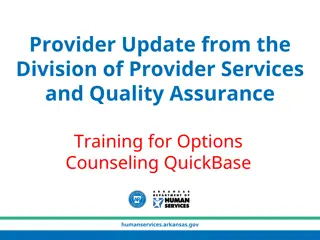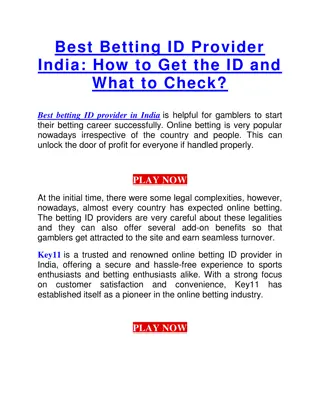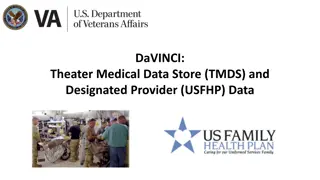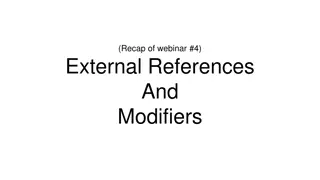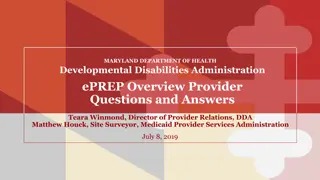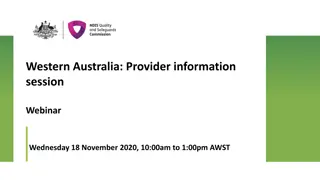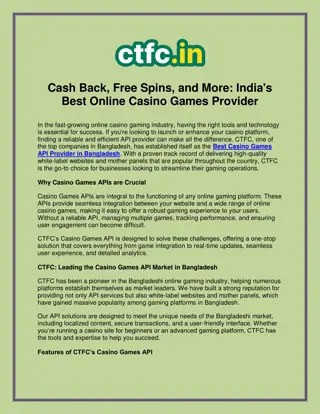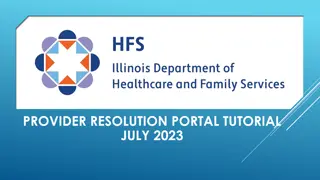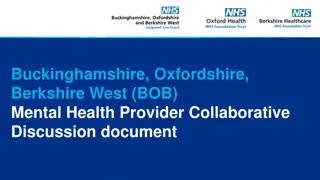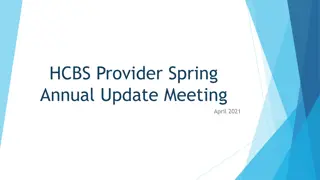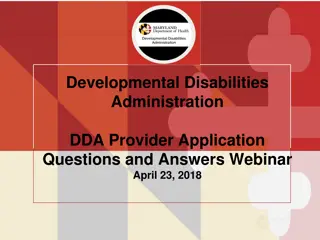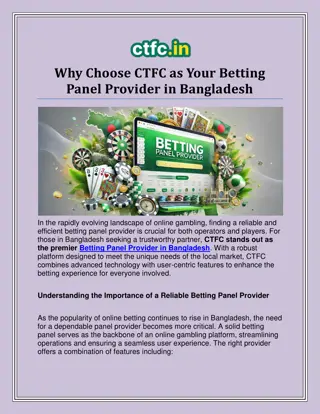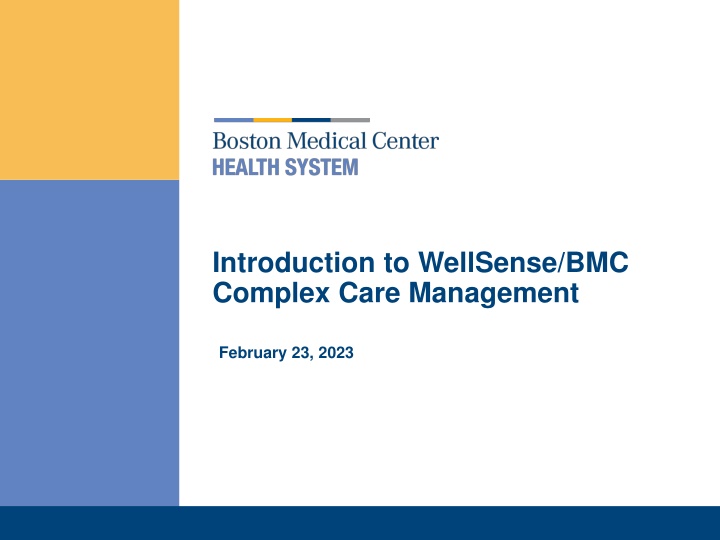
Comprehensive Overview of WellSense/BMC Complex Care Management
Discover the integrated health system dedicated to serving vulnerable populations through comprehensive care, education, and research. With a focus on improving health equity and access, WellSense/BMC offers a range of services including specialty pharmacy, addiction treatment, and coordination of long-term support services. Learn about their mission, programs, and commitment to improving patient outcomes.
Download Presentation

Please find below an Image/Link to download the presentation.
The content on the website is provided AS IS for your information and personal use only. It may not be sold, licensed, or shared on other websites without obtaining consent from the author. If you encounter any issues during the download, it is possible that the publisher has removed the file from their server.
You are allowed to download the files provided on this website for personal or commercial use, subject to the condition that they are used lawfully. All files are the property of their respective owners.
The content on the website is provided AS IS for your information and personal use only. It may not be sold, licensed, or shared on other websites without obtaining consent from the author.
E N D
Presentation Transcript
Introduction to WellSense/BMC Complex Care Management February 23, 2023
We are a health system united by our mission to serve societys most vulnerable patients Medical Group ~500K MassHealth Medicaid members 180K+ member (all products) Largest safety net hospital in New England with 496 beds Academic multispecialty group practice providing, clinical care, teaching / education, research Operates in four programs in MA and NH Consists of 19 groups including BMC s on campus practices Largest provider of Emergency and Trauma Services in New England Responsible for 2 out of every 5 MassHealth ACO patients 18 clinical departments with 900+ physicians and other providers Participates in risk contracts with MassHealth, Medicare, Blue Cross, Tufts and Harvard Pilgrim 26K discharges, 1M outpatient visits and 20K OR cases per year Working to eliminate gaps in life expectancy and QOL among different races and ethnicities Umbrella for all of BMC's work in addiction Specialty pharmacy services provider specializing in complex, high-risk patients Serving ~1,200 individuals ages 3-64 in Boston and Revere National resource for revolutionizing addiction treatment and education Connects patients to LTSS services through care coordination Working in 5 clinical areas: Pregnancy, Cancer, ID, Chronic conditions, BH 2
The Population Health Services function is at the heart of shaping our ACO performance strategy, and the principle point of ACO collaboration WellSense Core HP functions Population Health Services Home for provider facing ACO performance levers ACO Centralized team of content experts that support system-wide ACO strategies UM Finance Claims payment ACO-based engagement model defined by ACO; our current ACOs are all slightly different System Analytics Customer Care Medical Management Director, PHS BILH ACO Public Partnerships ACO Risk Adjustment ACO Quality BMCHS leader dedicated to each ACO Enrollment Pharmacy Network Behavioral Health and others Others 3
Care Management Provider Training Agenda Broad summary of Care Management programs Patient Identification and Referral to CM Patient Identification and Referral to CM Transitions of Care/ Transition Guide for members in CM today Transitions of Care/ Transition Guide for members in CM today Appendix Appendix 4
WellSense CM programs overview Program goal CCM team embedded in primary care with the goal of establishing patients (particularly those with complex needs) with ambulatory care, and community based supports to achieve patient-identified goals, improve health related outcomes, and reduce avoidable hospital utilization Complex Care Management (CCM) Provide longitudinal support in the community for individuals age 18-64 with significant behavioral health needs, including serious mental illness and addiction Behavioral Health Community Partners (BH CP) Increasing program intensity Long term services and supports Community Partners (LTSS CP) Provide longitudinal support in the community for individuals age 3-64 with complex LTSS needs, such as children and adults with physical and developmental disabilities and brain injuries AND individuals with general health-related social needs. Provide enhanced care coordination, including transition of care, to high risk members with SPMI and baseline care coordination to non-high risk members with behavioral health or SUD needs. The services are provided telephonically and priority is given to members not already engaged in CCM or CP unless additional BH support is needed. Behavioral Health Care Management Address urgent, escalated, and inbound CM needs from patients, providers, and MassHealth; outreach to members based on HRA completion and identified needs for care management; manage high risk maternal and child health cases; provide baseline care coordination; help connect members to longer-term CM supports where necessary WellSense Central CM Provide health-related social supports for housing and nutrition in order to improve member health outcomes and reduce TCOC Flex Services 5 5
CM programs details Activities and clinical model Staffing model Intensive, face-to-face model based in clinical setting, integrated with primary care and IP; engagement with multiple provider types Multiple interactions per week across multiple settings, e.g., care manager may accompany patients to appointments 45-75 : 2 FTE (nurse + CHW or LCWS + CHW) Complex Care Management (CCM) Behavioral Health Community Partners (BH CP) 50:1 care coordinator 350:RN supervisor and 350:clinical care manager Moderate intensity care coordination; face-to-face and/or telephonic (not embedded with primary care) Includes outreach and engagement, assessment and care planning, care coordination, support for transitions of care, medication reconciliation support, health and wellness coaching, connection to social services and community resources Increasing program intensity Long term services and supports Community Partners (LTSS CP) Telephonic only, focused on high risk members with SPMI, TOC from BH facilities, and TCM/FUH Range of support varies depending on member needs (from more enhance care coordination to baseline care coordination) 75-100:1 care manager 80-110: 1 care coordinator Behavioral Health Care Management Roughly 100:1 care manager Telephonic only, care plan based on assessment and member engagement to address problems, goals, and interventions Engagement across providers and community supports Interactions of varying frequency based on member care plan One-time connection to social supports; no comprehensive care management (unless patient is referred through CM program) Case management for specific social need (eg via housing SSO) WellSense Central CM N/A no panel- carrying staff Flex Services 6 6
CCM: Our program targets highest risk patients for intensive, primary care and community-based interventions Patient Selection Intervention RNs, Community Wellness Advocates, BH and Pharmacy work as a team Patient Identification Triage Outreach & Engagement CAM Impactability Score used to select top 2% highest risk patients lists updated every 2 mos Often during inpatient stays or PCP visits Chart review to ensure patient remains high- need and is impactable Emphasis on face-to-face engagement Primary care based; collaborate with PCPs, specialists, pharmacists, home health, community agencies & others on: Provider referrals triaged in consideration of clinical criteria Chronic disease management Behavioral health Social determinants 6-8 month intervention with focus on building long-term supports and interventions to maintain SDOH needs Intervention includes: Establishing longitudinal care TOC support Expedited access to care (assessment and triage of symptoms) Patient education for better self management of conditions 7
Where CCM is embedded in primary care, the team collaborates directly with providers and clinic team CCM Staff will have regular scheduled time in the practice to facilitate ad hoc collaboration (dictated by availability of space in designated practice Co-Located At the request of the patient or the provider, CCM team member may accompany patients to their PCP appointment Facilitates advocacy, patient education, and application of plan of care in the patient s home environment Patient Accompaniment CCM team has access to clinic EMR system, and will regularly update progress toward patient s goals, and/or relevant clinical information Dependent on EMR capability, CCM team will coordinate with clinic team members via EMR messaging Coordination in the EMR At the request of the clinic/providers, CCM will hold regular scheduled meetings to review patients enrolled in CCM and collaborate on the plan of care Scheduled meetings The goal of CCM is to establish patients with clinic-based and community- based services. CCM will refer and provide warm hand-off to services (ie: OBAT, IBH, community based supports) Warm Handoff 8
What is a Community Partner (CP) and what do Community Partners Offer CPs are community-based organizations awarded by MassHealth and contracted with ACOs and MCOs to provide enhanced care coordination to MH members with complex needs. There are two types of CPs: Long Term Services and Supports Community Partners (LTSS CPs) -Provide LTSS care coordination and navigation to populations with complex LTSS needs Behavioral Health Community Partners(BH CPs) -Responsible for care management and coordination for populations with significant BH needs How to partner with CPs Community Partners responsibilities to patients Assessment & Care Planning Comprehensive Assessment expected which must be person- centered with member- identified and approve goals. Recommendations for ACO Groups Care Team Coordination Facilitate communication among members and act as subject matter experts for BH/LTSS community services Outreach to Patients To encourage members to participate in the program, expected a min of 3 attempts, including at least one face-to-face Generate referrals Warm handoffs PCP engagement with CP/patient Provide EMR access to CPs Site CM or CCM leverage community expertise of CP Provider a clinic Point of Contact (POC) for CPs/Wellsense Connection to Social Services Assist enrolled members with SDOH needs including referral to Flexible Services Care Management Transitions of Care Assist with discharge planning, appointment access/follow-ups and a face to face interaction within 3 days post- discharge Coordinate between member s, state agencies, specialty providers. Connect programs appropriate for members A point of contact (POC)acts as a liaison between each site s PCP and CP who has a relationship with the site s PCP and has access to member demographic data. 9
WS BH Care management is facilitated telephonically to support members through programs with varying intensity, duration and scope of work Program for members with SPMI, lack of support, co-morbidities, and/or high inpatient utilization Includes: Assessment and screenings, Plan of Care, frequent interventions, collaboration with other departments, disciplines, and providers. Age: 18+ BH Enhanced Care Management (BH ECM) Enhanced Care Coordination Staff: LMHCs or LICSWs BH Care Managers Targets those members who have been rapid-cycling through inpatient admissions over the past year (4> admits last 12 months) Multi-disciplinary team consisting of health plan, Beacon (Carelon), CCM and BEST leaders, with monthly efforts facilitated with ACO clinical teams, CPs, BH specialty providers and state agencies Age: All ages Rapidly Readmitting Member (RRM) Program for members that are in need of transition of care from an inpatient psychiatric facility to a lower level of care or to the community Members that are part of the program tend to have multiple readmissions within a short period of time Ages: 18+ BH Transition of Care (TOC) Baseline Care Program for members that need assistance navigating the health care system and have difficulty finding a BH/SUD provider or have history of non-compliance with treatment Consultation with another CM to address concerns of a members with a possible BH/SUD disorder(s) and / or case exploration These members do not meet criteria for or have declined BH ECM Ages: All ages Coordination Coordinators BH Care Coordination and Consultation Staff: BA BH Care BH CM works in collaboration with health plan and Beacon (Carelon) clinical teams, BH CPs, ACO CCM teams and other programs Author: Henry Hernandez-Torres 10
WellSense Central CM: Telephonic care management and care coordination program for members with medical and/or social needs Patient Selection Intervention Program Staff Focused on connection to care across the care team; collaborate with PCPs, specialists, pharmacists, home health, community agencies & others on: Patient Identification Low acuity patients RNs Social Workers Community Health Workers Care Coordinators HRA response Ad hoc referrals from providers, members, State agencies, UM Work as a team to support members with medical and/or social needs, provide healthcare educational materials, or facilitate coordination of care Chronic disease management Social determinants Outreach & Engagement Outreach to member after HRA completion in follow-up to identified needs, as applicable Interventions includes: WellSense Central CM team may co-manage cases with BHCM based on member needs. Establishing longitudinal care TOC support Patient education for better self management of conditions 866 line takes live member calls from Member Services Engagement tenure may be short term care coordination, or longer term 6-8 month interventions with focus on building long-term supports and interventions to maintain SDOH needs Outreach to member based on referral, also may be a referral source for members graduating from CCM in need of additional support. 11
What is the MassHealth Flexible Services Program (FSP) Flexible Services program provides health-related social supports for housing and nutrition with the goal of improving member health outcomes and reducing TCOC * CM teams will often make Flex referrals. Providers can also initiate referral directly to Flex. Pre-tenancy: assisting members with obtaining and completing housing applications; Transitional assistance funds to support one-time household set up costs and first/last month s rent Tenancy Sustaining: assisting members with communicating with landlords; obtaining adaptive skills needed to live independently in the community FSP supports: Home Modifications: needed to ensure member s health and safety (e.g., installation of grab bars and hand showers; doorway modifications; in-home environmental risk assessments Nutrition: includes goods, transportation, and services that educate members about appropriate nutrition and help members access food needed to meet their nutritional needs. 12
Appendix Broad summary of Care Management programs Broad summary of Care Management programs Patient Identification and Referral to CM Transitions of Care/ Transition Guide for members in CM today Transitions of Care/ Transition Guide for members in CM today Appendix Appendix 13
How are members identified for CM? Proactive identification Members may be flagged using our proprietary risk algorithm, based on utilization patterns and social needs. Provider referrals PCPs or other providers may identify patients as candidates for CM details follow Member referrals Members can self- refer (by calling WellSense) or note on their care needs screening (upon enrollment) response that they are interested in CM Referral from another CM program A CM working with a member may graduate them into a less intensive program, or escalate them into a more intensive one Care management programs 14
How do I decide whether to refer a member to care management (vs. other services)? Refer to CM Refer directly to Flex Services Targeted Outreach Member needs longitudinal support with managing chronic conditions and/or BH/SUD problems, including: Getting connected to care Getting connected to social services Self-management Member needs help getting connected to social services (nutrition or housing) Member appears on a gap list for a quality measure Member needs help scheduling a follow-up appointment with a PCP, or education on managing a specific condition Member has chronic conditions that are relatively stable If member has chronic conditions that are not well- managed, refer to CM Member needs a referral to a specialist or other provider Clinical trajectory is coming to more acute without intervention, they likely will have more ED or IP utilization We do not anticipate that the housing or nutrition need will have a substantial impact on their healthcare costs or outcomes Short-term supports (e.g., direct provider outreach, referral to Flex) have not been sufficient to help the member improve access to care or outcomes Note: CM programs will also often refer members to Flex Services as part of the overall CM service offering Example: Patient with DM II, poorly controlled. Non-healing foot wound complicated by food insecurity, poor attendance to ambulatory appointments Example: First trimester mom with preexisting diabetes reports food insecurity or housing insecurity. Chronic disease management is relatively stable Example: Spanish-speaking patient with a new diagnosis of heart failure needs assistance establishing with cardiology, and initiating self- management of condition 15
How do I make a referral to care management? WellSense has a centralized referral form for all CM referrals. If you are unsure which program is best suited for the patient, please send it to ACOCMReferral@wellsense.org. If you know the patient should be referred to CP, please send to (BHCP@wellsense.org, or LTSSCP@wellsense.org) or to BH CM send to (BHCMReferrals@WellSense.org) If you have CCM staff on-site, follow your clinic workflow to refer the patient to care management or directly contact your embedded CCM team. 16
We will have a central CM referral coordination function to streamline CM enrollment and reduce duplication Patient is enrolled in CCM Eligible for CCM Embedded CCM team evaluates referral Practice with embedded CCM Referral to CCM Central WS referral coordination function: Goal is to coordinate CM enrollment, ensure patients are connected to the appropriate program, and minimize duplication. - Generates and reviews central list of all algorithmic refertals - Coordinate provider referrals Triages and determines appropriate CM program (CCM, CP, BH CM, or other) Passes referral to appropriate CM team for next steps Not eligible for CCM Referral to other CM (lower acuity) Practice without embedded CCM Refers member to CCM or other care management 17 17
Appendix Broad summary of Care Management programs Broad summary of Care Management programs Patient Identification and Referral to CM Patient Identification and Referral to CM Transitions of Care/ Transition Guide for members in CM today Appendix Appendix 18
Transitions of care how are members supported? We provide TOC support with varying intensity (depending on patient needs) for both medical and CP transitions. How we define a TOC activity: 72h follow-up (in-person where possible, telephonic where not) that includes med rec, plus primary care appt within 7-14 days. Referral to appropriate CM program where relevant. Population Who conducts TOC? Enrolled in CCM CCM care manager already working with member High-risk (top 6%), not enrolled in CCM CCM team CP or BH CM enrolled CP or BH CM care manager; recommended that provider also conducts TOC outreach for these members Enrolled in telephonic WellSense Central CM WellSense Central CM Low risk, not enrolled in CM medical transitions Recommended that provider conduct TOC for certain members Discharges from BH facilities WellSense and Beacon (Carelon) Note on TOC duplication: We have designed our TOC program to ensure that members do not fall through the cracks (i.e., a member who needs TOC support gets it). This means that in some cases where sharing real-time information is difficult (e.g., CP enrollment), we may have duplicative TOC outreach rather than risk having none at all. 19
How will we transition members currently receiving CM services? We develop a transition guide which provides details of WellSense Care Management programs and eligibility criteria to triage patients enrolled in care management through your legacy ACO programs to care management services at WellSense. As well as, a pathway to graduate current patients out of care management services. Note:There may be slight variation per ACO partner. CM Graduation Pathway 1. For patients whose health-related goals are stable OR they no longer need care management support, plan graduation from care management with their existing CM team prior to April 1. CM Member/Patient Classification 1. Care management maintenance Patient is relatively stable with their health- related care goals & ongoing services are needed after April 1st. 2. Acute care management need Patient(s) who are recently enrolled in care management with the legacy ACO, or the patient goal(s) or identified need(s) are not yet addressed. 2. For patients who are no longer engaging in care management services (the care team has not reached the patient for greater than one month despite attempts to outreach). Plan to graduate/dis-enroll patients from care management services with their existing CM team prior to April 1. Patients classified under care management maintenance OR in need of acute care management will be guided through eligibility criteria for: - CCM - CP CM (member transitions will be handled by MassHealth through auto-enrollment. Post 4/1, CP CM team may assist with advocating for members who may need an exception to MassHealth s auto-enrollment assignment.) - BH CM - Telephonic Care Management 20 20
Appendix Broad summary of Care Management programs Broad summary of Care Management programs Patient Identification and Referral to CM Patient Identification and Referral to CM Transitions of Care/ Transition Guide for members in CM today Transitions of Care/ Transition Guide for members in CM today Appendix MassHealth and NCQA requirements MassHealth and NCQA requirements Enrollment targets Enrollment targets Community Partners and Flex Services enrollment Community Partners and Flex Services enrollment 21
Enhanced care coordination clinical components / model Element Description Rationale / source of requirement Comprehensive Assessment and Plan of Care All members enrolled in care management must have a comprehensive assessment and plan of care documented in the EMR NCQA, EOHHS Model Contract (2.4.b & 2.5) Key TOC functions 72-hr follow up calls for all enrolled members, including those not yet engaged in CM but on a roster in the outreach phase EOHHS Model Contract (2.6.C.5), NCQA Availability of staff for in person and community work Staff must meet members face-to-face in various settings, including their homes, clinical and other community settings EOHHS Model Contract requires some face-to-face interaction (2.6.C.3) Evidence-based practice Time-limited intervention with throughput / key criteria for graduation Goal-oriented intervention determined by patient s plan of care; patient graduates when goals are achieved or supported Must be processes in place to ensure members move through and graduate from the program ROI objective is to touch enough members that program has positive ROI Multidisciplinary staff w/ BH, clinical, and SDoH capability Care team must be able to address members BH and SDoH needs, which requires that expertise in the team itself EOHHS Model Contract (requires care plan to address these needs 2.6.C.4.d) Evidence-based practice Ongoing training Ensure initial training on care management principles, and ongoing training for best practice may be supported by WS; can leverage EOHHS TA dollars Quality of intervention Robust integration with primary care sites Primary care sites must be involved in care planning, ongoing member engagement, and graduation. Ideally sites engage PCP champion to foster engagement. EOHHS Model Contract (2.6.C.4.a) requires PCP involvement Quality of intervention Sufficient staffing CM staff are dedicated to CM and care coordination activities Requirements must be met regardless of staffing constraints Defined staffing ratio not to exceed 1 dyad:200 lives managed per year; ratios may vary with clinical justification Panel size and composition may vary but must provide an adequate intervention for the top 3-4% Quality of intervention EOHHS Model Contract (2.6.D.3) 22
Summary of baseline and enhanced care coordination requirements Baseline care coordination Enhanced care coordination All enrollees High and rising risk enrollees ~6-8% members, which considers those: Experiencing SED/SPMI and/or SUD With a history of waiting in EDs for disposition to BH services Chronically homeless, experiencing homelessness or housing instability Medical complexity Unmet LTSS needs Special Health Care Needs Transitioning between sites of care ID d by EOHHS for an enhanced CM program Self-ID d as benefiting from enhanced CM High-risk perinatal Who receives it? Need to check that risk algorithm includes these factors Initial care needs screening incl. for physical health, BH, LTSS, and HRSN Facilitating referrals to HRSN-related supports Assigning a PCP, appropriate services and referrals, provider follow-ups on tests/treatments/services, provision with info and counseling on care options Coordinating with service providers, CSOs and state agencies to improve integration of care Facilitate transitions to different settings of care; provide support and follow-up during and after Facilitate comm. between enrollees providers Documentation, record sharing between providers For enrollees with BH needs: Additional screening + treatment planning For enrollees <21: utilize family-centered approach, coordinate w/ school/early childhood supports, CBHI, state agency supports, etc. Enrollees ID d for enhanced care coordination must be enrolled in EITHER an ACO Care Management Program, OR a CP program, OR both. For those enrolled in both, CP program serves as lead care coordination entity (ACO CM team participates in Care Team convened and led by CP) For those in ACO CM <21 receiving Intensive Care Coordination or MassHealth Cares for Kids, that provider is the lead entity for CC What does the program entail? Must include: Best efforts to successfully outreach and engage enrollees within 30 days of assignment to program Multi-disciplinary care team formed in accordance with needs and preferences of the enrollee Activities of care team: coordinates across providers, provides intensive support for transitions of care, coordinates supports to address HRSNs, coordinates housing support using HMIS where appropriate Medication review Health and wellness coaching activities Tailoring to meet the needs of enrollees <21 These are close to current CCM requirements; possibly > current plan CM 23
Care management in the new waiver: overall structure All enrollees: Baseline care coordination (incl. care needs and HRSN screening, etc.) Risk stratification Set of requirements that applies to ALL enhanced CC. More intensive than current plan CM efforts ~6-8% enrollees: Enhanced care coordination Additional ACO CM-specific reqs Additional CP- specific reqs ~3-4% enrollees: ACO CM ~3-4% enrollees: CP program 1% double counting allowed Does not further specify breakdown b/w CCM / other CM programs ~3% BH CP ~1% LTSS CP Enrolled working definition: assigned into the program (not agreed to participate or extended a signed care plan) over the course of the year. For CCM, this means Jiva open status + referral with at least one attempted outreach. 24 24
What populations are served by CPs? Patient Demographics BH CP LTSS CP Age 18-64 3-64 Enrollment criteria Predominant behavioral health need(s), such as: Serious and persistent mental illness (SMI) Serious emotional disturbance (SED) Substance use disorder (SUD) Co-occurring SMI/SUD Predominant LTSS needs, such as: Significant functional impairments A history of high and sustained LTSS utilization, or LTSS related diagnoses, including but not limited to: Members with physical disabilities; Members with acquired or traumatic brain injury or other cognitive impairments Members with intellectual or developmental disabilities (ID/DD) including Members with Autism. Excluded populations Program of Assertive Community Treatment (PACT), One Care, Program of All-Inclusive Care for the Elderly (PACE), the Senior Care Options (SCO) program. Children s Behavioral Health Initiative (CBHI) Intensive Care Coordination (ICC) services, Program of Assertive Community Treatment (PACT), MassHealth CARES for Kids, One Care, Program of All-Inclusive Care for the Elderly (PACE), the Senior Care Options (SCO) program. More detailed information on what clinical diagnoses and/or clinical scenarios may qualify an patient for either a BH or LTSS CP can be found in the Appendix 25
FSP Health Needs-Based Criteria Detail Behavioral health eligibility The member is assessed to have a behavioral health need (mental health or substance use disorder) (e.g., depression, bipolar disorder) requiring improvement, stabilization, or prevention of deterioration of functioning (including the ability to live independently without support); Physical health eligibility The member is assessed to have a complex physical health need, which is defined as a persistent, disabling, or progressively life-threatening physical health condition(s) (e.g., diabetes, hypertension) requiring improvement, stabilization, or prevention of deterioration of functioning (including the ability to live independently without support); High-risk pregnancy The member is pregnant and experiencing high risk pregnancy or complications associated with pregnancy including: individuals 60 days postpartum; their children up to one year of age; and their children born of the pregnancy up to one year of age. 26



